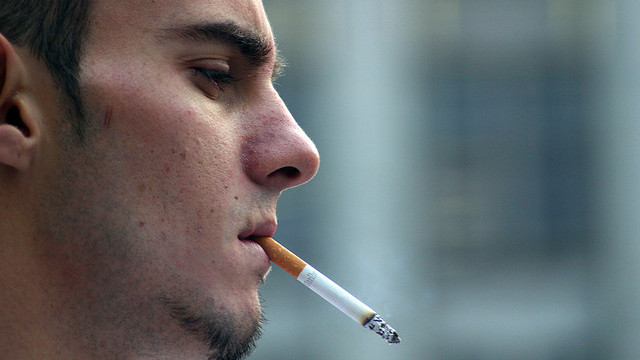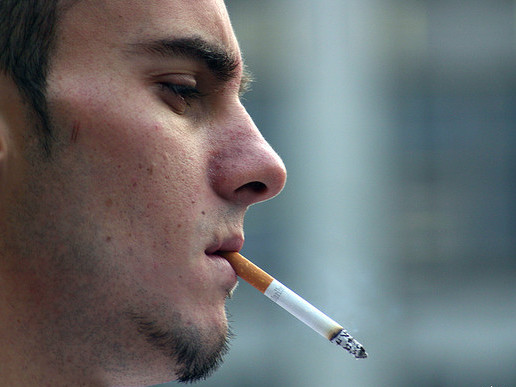
During the course of New York City Mayor Michael Bloomberg’s 12-year-tenure in office, he oversaw a litany of social health reforms to the nation’s largest city — including the banning of trans fats in restaurants, regulation of tanning salons, the requirement that calories must be posted on menus and the failed attempt to ban store-bought soft drinks in sizes larger than a half-liter. In the waning months of his leadership, one final reform is being pushed through to mixed opinions.
On Wednesday, the New York City Council voted Wednesday to raise the smoking age to 21 within the city, to set a minimum price per cigarette pack to $10.50 and to step up law enforcement on illegal tobacco sales. The measure passed 35 to 10 and will affect all tobacco products, including e-cigarettes, cigars and cigarillos.
“We know that tobacco dependence can begin very soon after a young person first tries smoking so it’s critical that we stop young people from smoking before they ever start,” the mayor said in a statement after the council’s vote. The national minimum smoking age is 18, which is standard in many cities and in most areas. Smoking is generally banned in public facilities, hospitals and restaurants.
Advocates for raising the smoking age feels that it will radically reduce the number of long-term smokers. According the Bureau of Alcohol, Tobacco, Firearms and Explosives’ 2013 “Monitoring the Future” report, the percentage of smokers who began smoking before the age of 21 is 90 percent. With 600,000 new teenage smokers each year, the ban hopes to to keep the addictive drug away from those that are easily impressionable.
“This is literally legislation that will save lives,” said council speaker Christine Quinn, who lost her bid for the Democratic nomination to be mayor to Bill de Blasio.
“By increasing the smoking age to 21 we will help prevent another generation from the ill health and shorter life expectancy that comes with smoking,” Bloomberg said. “It’s critical that we stop young people from smoking before they ever start.”
Are smoking bans working?
New York City’s smoking prohibitions will be the strongest in the nation. Several states — Alaska, Alabama, Utah and New Jersey — along with a scattering of counties and communities throughout the country mandates the minimum smoking age to be 19 — such as Nassau and Suffolk Counties on Long Island, Onondaga Co., N.Y. and its seat Syracuse and Needham, Mass., a suburb of Boston.
There is evidence to suggest that such actions will indeed reduce tobacco sales. For example, a recently released report from the Maryland Citizens’ Health Initiative showed that cigarette pack sales in Maryland has declined 17 percent since 2008, in light of a $2 cigarette tax hike. In Minnesota, the state’s hiking of the tobacco tax by nearly 77 percent per pack has definitely deflated tobacco sales in the state.
However, the policy hasn’t defeated tobacco use in the state. North Dakota has reported significant gains in its cigarette sales, with sales in August being up 12 percent from last year’s totals, per the office of the North Dakota Tax Commissioner. According to the Mackinac Center, 20 percent of all cigarettes in Minnesota were smuggled in.
It’s unrealistic to say that stricter tobacco control laws will keep cigarettes off of the streets. But, they may serve to keep teenagers away from smoking.
“I think a 21-year-old is much more likely, based on their maturity and life experiences, to be able to make an informed rational decision about a behavior that might affect the rest of their life than, say, an 18-year-old,” said Dr. Michael Steinberg, director of the Tobacco Dependency Program at Rutgers University and co-author of a commentary appearing in the Annals of Internal Medicine that debates the merits of New York City’s proposal..
“Cigarettes and tobacco contain some of the most addictive chemicals in our society,” continued Steinberg. “Smoking a cigarette delivers more nicotine more efficiently to your brain than if you were to inject nicotine intravenously.”
Officials in New York City is projecting that raising the purchasing age for tobacco will reduce tobacco use by by 55 percent among 18- to 20-years old and lead to a 67 percent drop among 14 to 17-year-olds.
‘Little cigars’ are hooking kids
“Nearly all tobacco use begins during youth and young adulthood,” read the Surgeon General’s report, “Preventing Tobacco Use Among Youth and Young Adults.”
“These young individuals progress from smoking occasionally to smoking every day. Each day across the United States over 3,800 youth under 18 years of age start smoking. Although much progress has been made to reduce the prevalence of smoking since the first Surgeon General’s report in 1964, today nearly one in four high school seniors and one in three young adults under age 26 smoke.”
“Of every three young smokers, only one will quit, and one of those remaining smokers will die from tobacco-related causes. Most of these young people never considered the long-term health consequences associated with tobacco use when they started smoking; and nicotine, a highly addictive drug, causes many to continue smoking well into adulthood, often with deadly consequences.”
The Centers for Disease Control and Prevention has shown concern over the tobacco industry’s attempt to lure young smokers. In a study this month, the CDC said more than two in five middle and high school students that smoke have reported using a flavored cigarette — a cigarette which, like a menthol cigarette, is flavored to produce a fruity or candy-flavored smoke. According to the study, almost 60 percent of school-aged users of flavored cigarillos and little cigars are not considering quitting, compared to the 49 percent of regular cigar smokers that are happy with their habit.
“Flavored or not, cigars cause cancer, heart disease, lung disease, and many other health problems. Flavored little cigars appeal to youth and the use of these tobacco products may lead to disfigurement, disability, and premature death,” said CDC Director Dr. Tom Frieden. ”We need to take comprehensive steps to reduce all tobacco use for all of our youth.”
Per the CDC, teenagers have a higher cigar use than adults, and while cigarette consumption has decreased by nearly a third from 2001 to 2011, cigar and non-cigarette smoking paraphernalia has increased more than 123 percent. According to Frieden, the tobacco industry are deliberately targeting teenagers, as the fruit-flavors of the “little cigars”, their cheaper price — due to being exempted under most tobacco taxes — and visual similarity to other tobacco products make them overwhelmingly popular with minors.
“You can buy them in one, two or five packs. So, they’re more accessible to kids,” Frieden said. “And because of the flavors, they’re very appealing to kids. It’s frankly disgraceful that the industry is using this to get another generation of our kids hooked on tobacco.”
‘I buy or bum them off people’
Despite the call towards making tobacco unavailable to minors and young adults, many feel that New York’s proposal goes too far. Many argue that 18 to 21-year-olds, who are considered voting, military-eligible adults, should have full agency over what they can buy, without consideration of public health goals. Others feel that smokers will just buy from the black market or from outside the city. The ATF currently estimates 1.5 million cigarettes are sold illegally to minors annually, with one out of five smoking teenagers using between 13 and 15 cigarettes a day.
“New York City already has the highest cigarette tax rate and the highest cigarette smuggling rate in the country,” said Bryan Hatchell, a spokesman for R.J. Reynolds Tobacco Company, which makes Camel and other brands. “Those go hand in hand and this new law will only make the problem worse.”
Nicole Spencer, a 16-year-old smoker from New York, doubts the strength of the plan. “I don’t think that’s going to work,” Spencer said to the New York Times. She said she began smoking when she was about 13, and had no trouble getting cigarettes. “I buy them off people or I bum them off people.”
Interestingly enough, the American Lung Association has taken no sides on the effectiveness of raising the smoking age, stating that no evidence exists to substantiate the claims that this plan can effectively keep teenagers away from tobacco. The ALA feels that government policy and money would be better served enforcing existing tobacco-control laws, raising the tobacco tax and stepping up on prevention services.
“We need to attack tobacco industry marketing and advertising practices that glorify smoking to the underage set,” said Paul Knepprath, American Lung Association of California spokesman. “And we need to continue to enforce the laws in California. We’re still showing significant sales to minors over the counter.”


